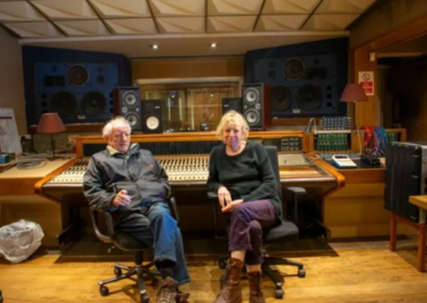Behind the Scenes: How Music Albums Are Made

The process of creating a music album involves several intricate stages, each contributing to the final product. It begins with songwriting, where artists draw inspiration to craft melodies and lyrics. Next comes pre-production, where ideas are refined and logistical considerations addressed. Recording transforms these concepts into sound, guided by the producer’s vision. However, the journey doesn’t end there—mixing and mastering play crucial roles in achieving the desired auditory experience. What happens next may surprise many.
The Spark of Inspiration: Songwriting and Composition
In the realm of music production, the initial phase of songwriting and composition serves as the foundation upon which entire albums are built. This process often begins with the spark of inspiration, leading artists to explore various lyrical themes that resonate with their experiences and emotions.
As they delve into these themes, melody development becomes integral, allowing for the creation of memorable hooks and harmonies that elevate the lyrical content. The interplay between lyrics and melody is crucial; it not only enhances the emotional depth of a song but also engages listeners on a profound level.
Through experimentation and refinement, songwriters craft compositions that reflect their artistic vision, setting the stage for the album’s overall narrative and sound.
Read more: The Rise of Social Media Influencers in Entertainment Industry
Pre-Production: Planning the Album
While the creative burst of songwriting is crucial, the pre-production phase is equally essential for shaping an album’s direction and coherence. During this stage, artists engage in concept development, refining themes and narratives that will resonate with listeners.
This process often involves brainstorming sessions, where musicians can explore various artistic visions and align their collective goals. Additionally, budget planning becomes a pivotal aspect, as it determines the resources available for recording, marketing, and distribution.
A well-structured budget ensures that creative aspirations do not exceed practical limitations, allowing for a balanced investment in both artistry and business. Ultimately, pre-production serves as the compass that guides the entire album-making journey, fostering a cohesive and intentional body of work.
Recording: Capturing the Sound
Recording an album represents a pivotal moment where creative ideas transform into tangible sound. This phase hinges on the intricate interplay of microphone techniques and studio acoustics.
Engineers meticulously select microphones tailored to capture the nuances of each instrument and vocal performance, optimizing placement to harness the desired tonal qualities. Various techniques, such as close-miking and ambient recording, affect the final sound, enhancing the emotional depth of the music.
Simultaneously, studio acoustics play a crucial role in shaping the recording environment; a well-designed space can prevent unwanted reflections and background noise, ensuring clarity.
The fusion of these elements culminates in a vibrant soundscape, where every note resonates with the artist’s vision, ultimately inviting listeners into an immersive auditory experience.
The Role of the Producer: Guiding the Vision
The producer plays a pivotal role in shaping the creative vision of a music album, guiding artists through the intricacies of the recording process.
This involves fostering collaboration and communication among various team members, ensuring that each element aligns with the overarching artistic goals.
Vision Crafting Process
Although the creative process of making a music album often appears spontaneous, it is the producer who plays a pivotal role in shaping its overall vision. This begins with vision alignment, where the producer collaborates with the artist to ensure that their individual artistic intentions resonate harmoniously.
Through concept development, the producer guides the evolution of thematic elements and musical direction, ensuring that every song contributes to the album’s cohesive narrative. They analyze the artist’s strengths and weaknesses, strategically selecting sounds and arrangements that encapsulate the desired aesthetic.
Collaboration and Communication
Successful album production hinges on effective collaboration and communication between the producer and the artist. The producer plays a pivotal role in guiding the vision, utilizing various collaborative tools to facilitate seamless interaction.
Different communication styles can significantly impact the teamwork dynamics, fostering an environment where creativity thrives. By establishing clear channels for dialogue, producers encourage artists to express their ideas freely, enabling a more authentic sound.
Feedback loops are essential in this process; they allow for constant refinement and evolution of the music, ensuring that every element aligns with the artistic vision.
Ultimately, a harmonious relationship between producer and artist not only enhances the quality of the album but also empowers the creative spirit inherent in music production.
Mixing: Balancing the Elements
While crafting a music album, the mixing process serves as a crucial stage where individual elements coalesce into a cohesive sound. This intricate procedure involves volume control to ensure every instrument and vocal is heard distinctly.
Engineers utilize mixing software to achieve frequency balance, preventing any one element from overpowering the others. Panning techniques are employed to create a spatial audio experience, allowing listeners to perceive depth.
Track layering enhances the richness of the soundscape, while maintaining a careful dynamic range ensures that the music retains its emotional impact. Audio effects are applied strategically to enhance textures and add character, culminating in a polished mix that reflects the artist’s vision, ready for the next step in the album creation process.
Mastering: Finalizing the Sound
As the final stage in the album production process, mastering plays a pivotal role in shaping the overall sound and ensuring consistency across all tracks.
This meticulous procedure involves fine-tuning audio quality, enhancing sound clarity, and preparing the album for distribution across various formats. Mastering engineers utilize specialized tools to balance frequencies, optimize levels, and apply subtle effects, ensuring each song seamlessly transitions into the next.
Additionally, mastering ensures that the album maintains its integrity whether played on high-end systems or standard headphones. By addressing issues like dynamic range and tonal balance, mastering helps artists achieve their desired sonic vision while also making the music accessible to a broader audience.
Ultimately, mastering is crucial for delivering a polished listening experience.
Artwork and Promotion: Presenting the Album to the World
The artistry of album presentation extends beyond the music itself, encompassing the visual elements and promotional strategies that capture the audience’s attention.
Album artwork serves as a critical visual representation of the music, often conveying themes and emotions that resonate with listeners. A compelling cover can evoke curiosity, encouraging potential fans to explore the sounds within.
Meanwhile, promotional strategies play a vital role in disseminating the album to the world. This includes everything from social media campaigns to launch events and partnerships with influencers.
By blending striking visuals and innovative marketing, artists create a cohesive identity, inviting listeners to engage with their work on multiple levels.
Ultimately, effective presentation amplifies the music’s impact and fosters a deeper connection with the audience.
Conclusion
The creation of a music album is akin to crafting a tapestry, where each thread—songwriting, production, and mixing—intertwines to form a vibrant whole. This intricate process not only captures the artist’s vision but also resonates with listeners on a profound level. As the album is finalized and presented, it becomes a shared experience, inviting audiences into a rich auditory landscape that reflects the complexities of human emotion and creativity. Ultimately, each album is a story waiting to be explored.




